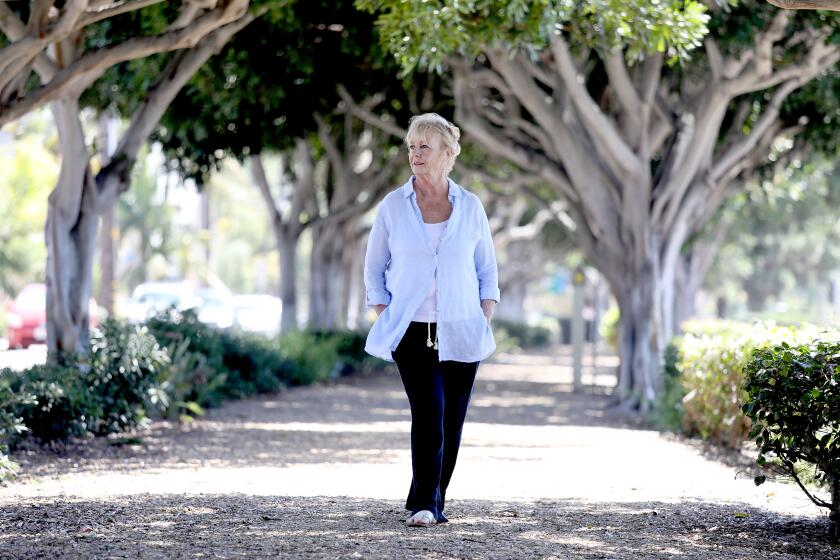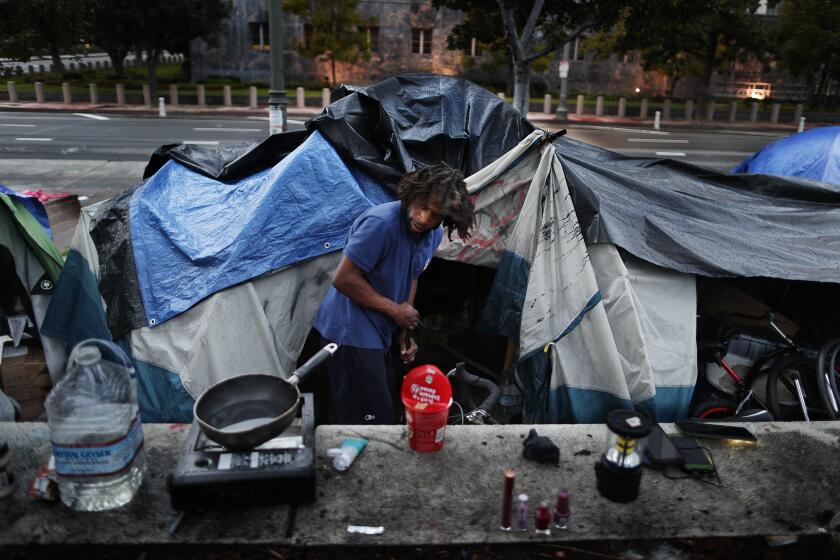California is reinventing how it deals with mental illness. Now the locals have to make it work

- Share via
Earlier this year, when Gov. Gavin Newsom laid out the agenda for his second term, he made clear his ambition to reform the state’s behavioral health system. By signing into law on Tuesday an expansion of conservatorship criteria, and then approving a ballot measure on Thursday to increase funding for housing and health services, he has come closer to achieving his goal.
“Today marks a powerful and important milestone,” Newsom said at a signing ceremony at Los Angeles General Medical Center for the twin funding bills — AB 531 and SB 326 — that will appear on the March 2024 ballot as Proposition 1. “I think this is a big day for not only the state. But I think this is a model for the nation as well.”
Voters will be asked to approve a $6.38-billion bond issue to add 11,150 treatment beds and supportive housing units, as well as provide outpatient treatment for close to 27,000 individuals.
The ballot measure would also reallocate approximately $1 billion in existing funds to provide services, develop new programs and operate the facilities.
Joining him was one of the primary architects of the legislation, Sen. Susan Talamantes Eggman (D-Stockton), who was a co-author of last year’s Community Assistance, Recovery and Empowerment Act, also known as the CARE Act.
“We have never had a bigger crisis than we have on our streets and in our community and in our political narrative,” Eggman said. “No longer will we look away. … The days of looking away are over.”
But reform has no clear metric for success, and experts argue that a crisis decades in the making will take years, if not decades, to address. Opposition has already formed to the ballot measure, arguing that it would lead to cuts in community-based treatment programs and an expansion of involuntary treatment options.
Together with the CARE Act, whose courts opened on Oct. 2 in seven counties statewide, the latest legislation represents a seismic reorientation of how mental illness is understood and treated.
By expanding the definition of “gravely disabled” with the addition of substance use disorder, SB 43, signed Tuesday, allows more opportunities for holding someone against their will, and Proposition 1 will help pay for more mental health campuses, supportive housing including locked facilities and healthcare staff.
The changes are substantive, said Luke Bergmann, director of behavioral health services for San Diego County, but they feel scattered “coming all at once from multiple directions but not always coordinated.”
CARE courts open in several California counties Oct. 2. Some families and others question the voluntary-compliance aspect of the mental illness law.
“This moment,” he said, “is not the result of an overarching strategic plan. What we’re facing now are many simultaneous efforts, which may work together or against one another.”
What is missing, Bergmann says, is an effort to address structural inequity in the behavioral health care system. He would like to see insurance companies be as accountable as county governments when paying for services, and he would also like to see more funding devoted to personnel than infrastructure.
“So much of the conversation has been about furniture — the number of beds — when it should be more about people,” he said.
Jonathan Sherin, former director of mental health for Los Angeles County, calls the legislative efforts “well-intended but disappointing” because they focus less on outcomes than on processes.
Counties, he argues, do not need more mandates from legislators for getting people into treatment. Lawmakers instead need to support counties as they come up with their own methods for meeting outcomes defined by each community.
“You have great, smart people working in a system that is difficult to maneuver in or redirect,” he said. “But so much more could be happening if you were to reverse-engineer the system, so that grassroot efforts inform the top.”
The results leave behavioral health directors like Bergmann to try to anticipate the impact of the new laws upon their agencies and the personnel who support mental health treatment programs.
The CARE Act and SB 43 are of particular concern because of how they complement each other.
Proponents of the CARE Act argue that its individualized treatment plans are voluntary, but if respondents fail to comply, the presumption will be they are gravely disabled, triggering an involuntary — or 5150 — hold, which is the first step toward conservatorship.
SB 43 makes that determination easier.
Gravely disabled is now more than just the inability to provide for food, clothing or shelter. It is also the inability to attend to personal safety and necessary medical care or to understand the nature or purpose of efforts to provide help. Whether these new criteria will be challenged in court remains to be seen.
“Many, many people who are chronically homeless in the streets of California could reasonably be determined to meet these broader criteria,” said Bergmann, who worries that SB 43 will lead to an increase in involuntary holds that will diminish the usefulness of the CARE Act.
These holds will add to the burden on a healthcare system that is already stressed by other mandates coming from Sacramento, he said.
Hospitals are struggling to meet the demands of a 2030 deadline for seismic retrofits, and budgets will be stretched thinner now that Newsom on Friday signed SB 525, establishing a $25 hourly minimum wage requirement for health workers.
Bergmann anticipates the effects of SB 43 will be felt in emergency rooms, often the initial destination for treatment and assessment. This places the burden on law enforcement and psychiatric clinicians who must decide whether to apply a temporary 5150 hold or extend it beyond 72 hours.
Given the effectiveness of anti-psychotic drugs and a shortage of psychiatric facilities for longer-term treatment, Bergmann does not immediately expect many of these holds to be extended, but he does anticipate a change in the culture of emergency rooms where the fast pace of treatment is often antithetical to helping people who have been detained, especially for substance use disorder.
Effective treatment, he said, takes time and trust.
The prevalence and lethality of methamphetamine and fentanyl on the streets have forced legislators to react. While previous efforts to expand the definition of gravely disabled have failed, SB 43 was passed with a sense of urgency that concerns Alex Barnard, an assistant professor of sociology at New York University.
“With the degree of suffering and actual dying accelerating, we are all for forging ahead aggressively,” he said, “but if it is not done thoughtfully, it could go wrong.”
He anticipates an increase in conservatorships, but as he reports in his recent book, “Conservatorship: Inside California’s System of Coercion and Care for Mental Illness,” there is no clear understanding of what the goals of conservatorship are.
Some public guardians believe that conservatorship is permanent, designed for people who will never be able to live on their own, he said. Others consider it temporary, meant to help people eventually live on their own.
As a result, conservatorships are applied less for the purpose of providing long-term treatment than reducing the use and cost of emergency services for those who cycle through 5150 holds, arrests and emergency room visits.
The absence of clearly defined outcomes is a stumbling block for getting treatment to those who need it the most, said Sherin, who has long argued that effective psychiatric care comes from providing medical services, family support and a reason to get up in the morning.
“Right now,” he said, “we’re throwing money at the problem and hoping that something works. Instead we need to determine what we want and pay counties to meet that goal — on their own.”
Sacramento lawmakers approved changes to California’s landmark behavioral health law. The measure now goes to Gov. Gavin Newsom.
But lawmakers in the recent legislative session seemed to show little interest in consulting with a broad constituency, according to Deb Roth, a senior legislative analyst for Disability Rights California, and were more intent upon marginalizing critics like her organization for “allowing the mentally ill to die with their rights on.”
“That is insulting and not true,” she said.
Roth cites in particular a last-minute change to AB 531. For months this year, as the bond measure worked its way through the Assembly and Senate, its funding — $6.38 billion — was earmarked for “an array of voluntary, unlocked, community-based treatment and residential care settings.”
But lawmakers in the last week deleted that language, making funding possible for locked psychiatric facilities.
The ballot measure going before voters in March represents a significant shift in how mental illness is paid for and treated in the state and poses a serious challenge to the status quo, said Rod Shaner, former medical director of the Los Angeles County Department of Mental Health.
“This could invite struggles with powerfully entrenched elements of the community mental health system,” Shaner said.
In reallocating funds in the Mental Health Services Act, Proposition 1 threatens funding for existing outpatient mental health services.
The change was probably inevitable, Shaner argues. The current system of community care, dating back to the Mental Health Act of 1963, had lost much of its credibility.
“With stresses on society — homelessness, visibility of severe mental illness — it has become apparent that no matter how much money we were putting in community mental health treatment it has not been effective for treatment of everyone with severe mental illness,” he said.
In assessing his needs for the future, however, Bergmann sees more of a need in San Diego County for unlocked community care facilities.
Although locked facilities for patients who have been discharged from hospital settings are necessary, he said, “we want to evolve to settings that are less restrictive, so people can live with a sense of purpose and place as a reflection of their agency, as opposed to places where they are prescribed clinically.”
“That is our north star,” he said.
More to Read
Sign up for Essential California
The most important California stories and recommendations in your inbox every morning.
You may occasionally receive promotional content from the Los Angeles Times.













